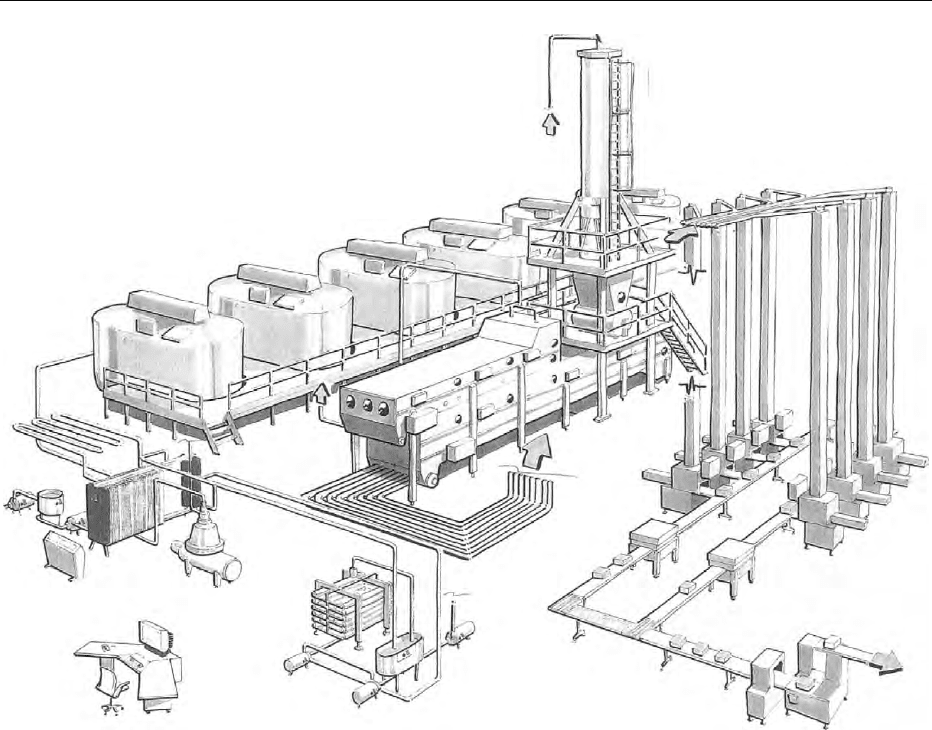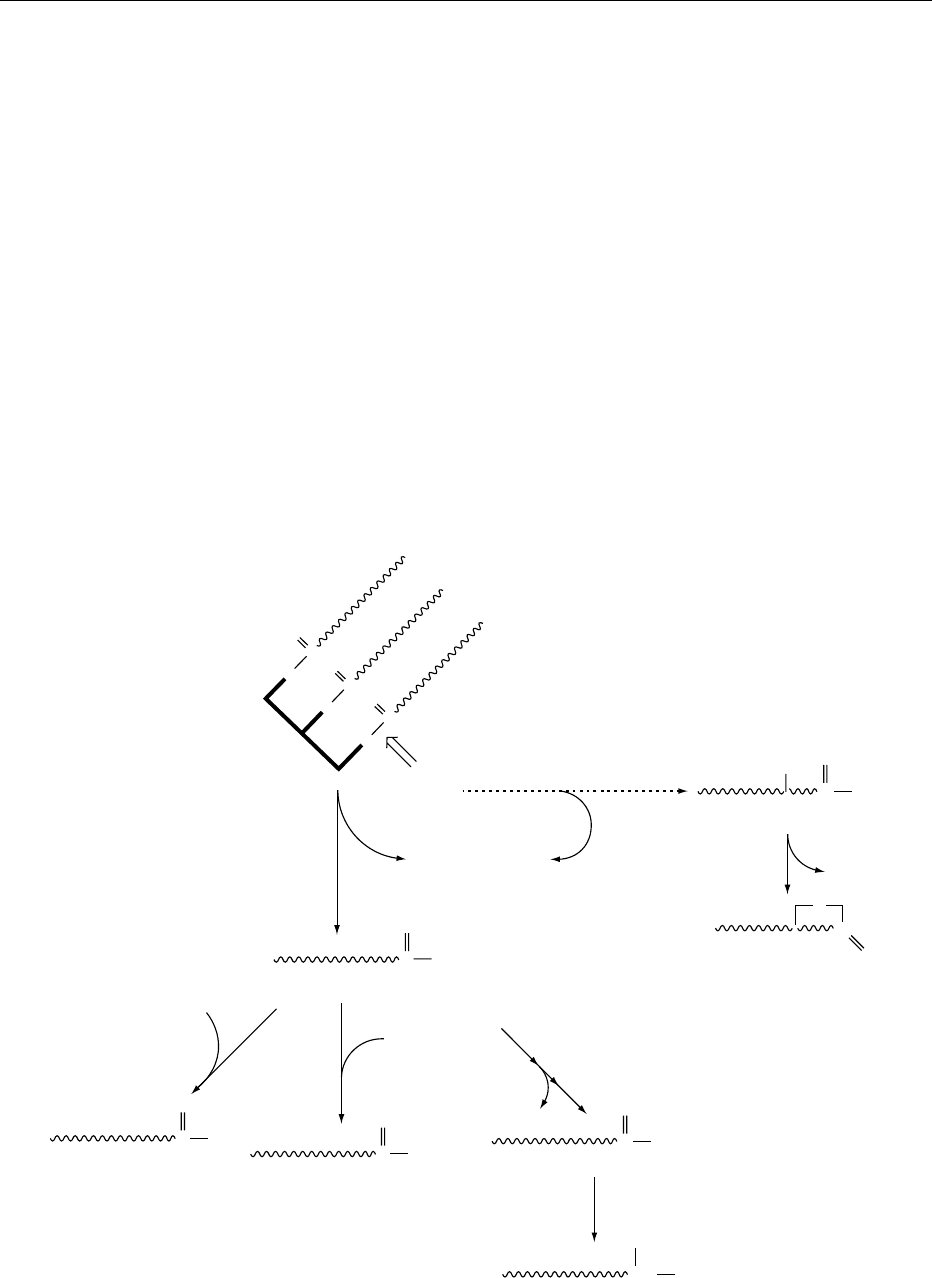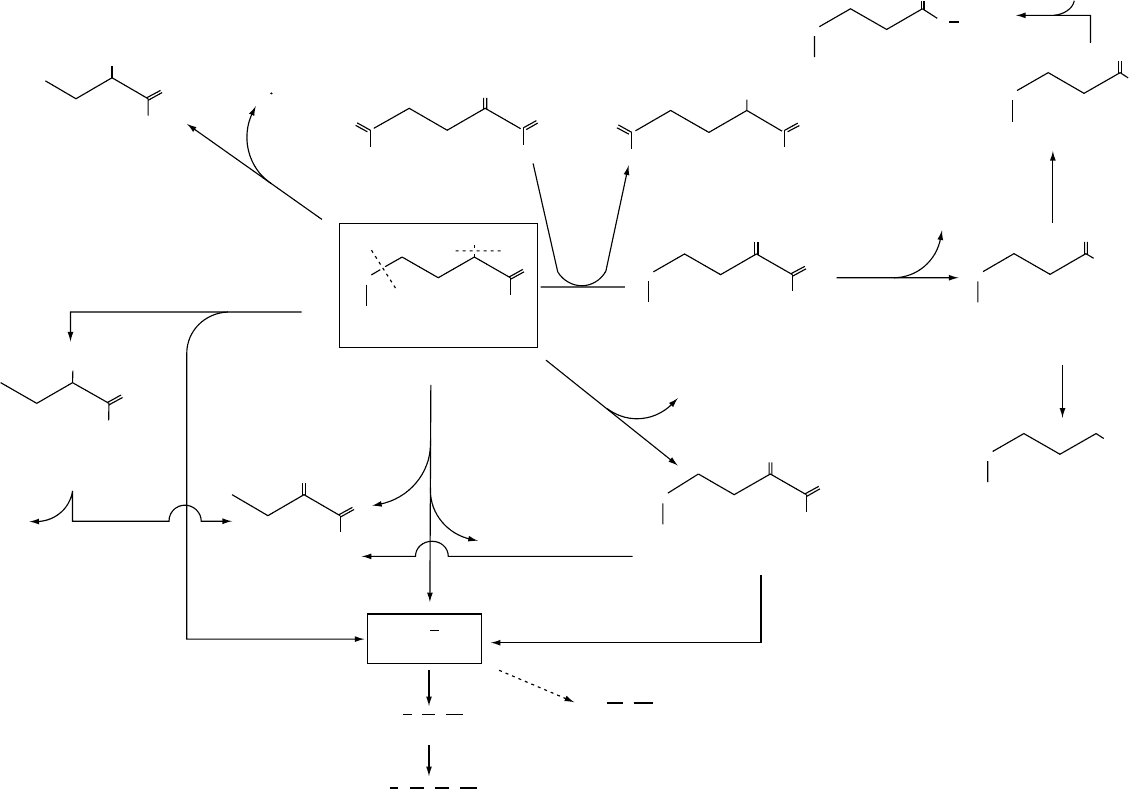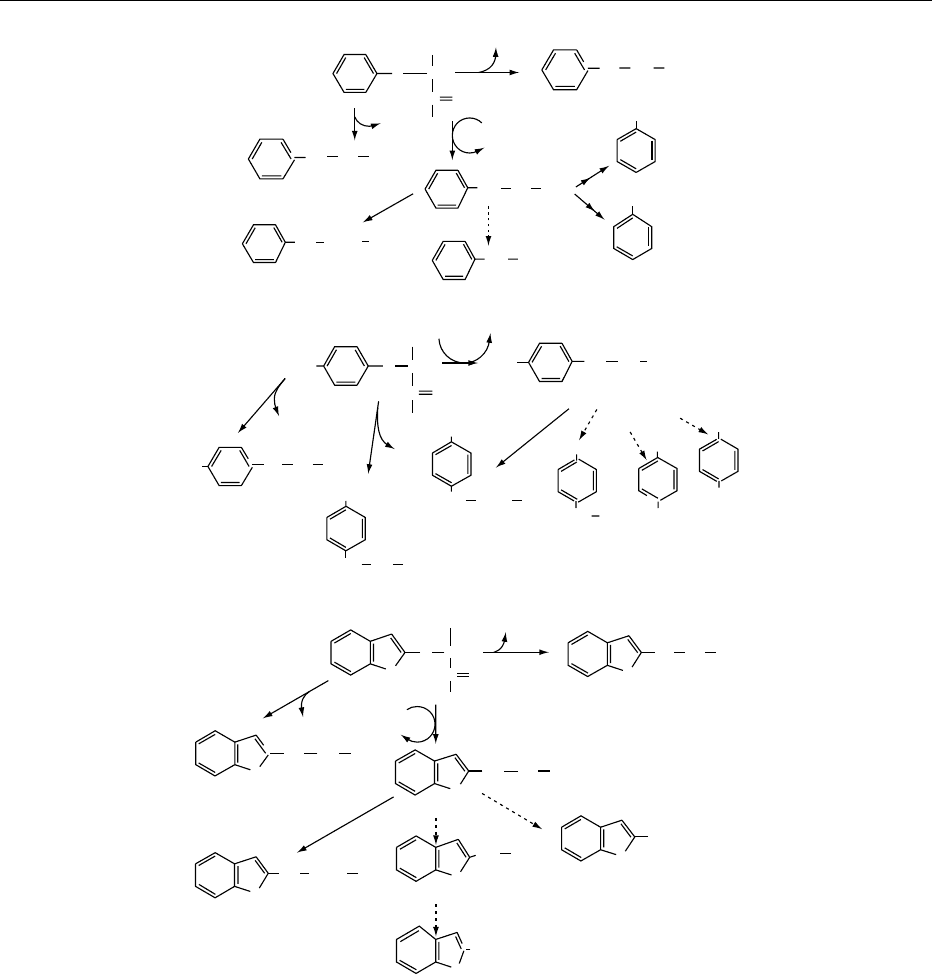Caballero B. (ed.) Encyclopaedia of Food Science, Food Technology and Nutrition. Ten-Volume Set
Подождите немного. Документ загружается.


0017 The possibility of using ultrafiltration (UF) to con-
centrate milk to ‘precheese’ for Cheddar cheese has
been investigated, but the texture and flavor of the
product are unsatisfactory. However, UF retentate is
used to standardize the fat and protein content of
cheese-milk.
Other Hard Cheeses
0018 British Territorial varieties are a group of cheeses
which originated in various parts of Great Britain.
The most important of these is Cheshire, which has
a crumbly, hard texture and several mechanical open-
ings. The milk is inoculated with * 4% of a meso-
philic starter, and the curds are cooked at 32–35
C,
which results in a lower pH, a shorter manufacturing
time, a higher moisture content, a lower calcium
content (due to the lower pH at whey drainage),
and a more crumbly texture than for Cheddar. The
curds are held on the bottom of the vat after whey
drainage, and the bed is broken occasionally to
prevent the development of an extensive structure.
Cheshire curds are dry-salted at * 3%, placed in
molds, drained overnight, pressed, packaged, and
matured at 6–8
C.
0019Leicester is similar to Cheshire but is normally
colored with annatto. The curds are cooked at
* 37
C and pressed after whey drainage; blocks of
curd are placed on draining racks, turned, and cut to
promote whey drainage. The cheeses are dry-salted
and matured for 4–8 months at 10–15
C. Derby is a
little-known English variety with properties generally
similar to those of Leicester; it contains 48% FDM
and about 42% moisture.
0020Gloucester is manufactured by a process similar
to that for Cheddar and is colored with annatto. The
curds are cooked to 35–38
C, textured, milled twice,
dry-salted and pressed into cylinders about 40 cm in
diameter and 6–8 cm high for ‘Single’ Gloucester and
15–20 cm high for ‘Double’ Gloucester. The cheeses
are matured for 4–6 months at 10–13
C.
0021Cantal, a hard cheese from the Auvergne region of
France, is manufactured by a process somewhat simi-
lar to that used for British Territorial varieties. The
milk is coagulated using calf rennet and acidified by a
mesophilic lactic starter. The curds/whey mixture is
not cooked, but the drained curds are cheddared and
pressed to promote whey drainage. The blocks of
curd are milled, dry salted, molded, pressed, and
matured at 8–10
C for 3–6 months.
0022Kefalotiri is a Greek cheese made from pasteurized
sheep’s or goats’ milk standardized to c. 6.0% fat. The
milk is inoculated with a thermophilic culture (usually
Sc. thermophilus and Lactobacillus delbrueckii ssp.
bulgaricus) and coagulated by calf rennet. The curds
are cooked to 43–45
C, transferred to molds lined
with cheesecloth, and pressed at an increasing pres-
sure. The pressed cheeses are brine-salted initially and
then rubbed with dry salt for a few days to give a final
salt content of c. 4%. The cheeses are washed occa-
sionally with a brine-soaked cloth to control micro-
bial growth on the surface and ripened for c. 3 months
at * 15
C. Kefalotiri has a hard texture and a strong,
salty flavor.
0023Graviera is also produced in Greece, principally
from ewes’ milk, which is acidified by a mixed culture
[pH ~ 5.4]
Dry Salt
Ripen
Mill
Cheddar
[Raise temperature:
30⬚C to 37−39⬚C
over ~ 30 min;
hold for ~ 1 h]
Cook
Cut
Starter (1−2%, v/v):
Lactococcus lactis ssp. cremoris
and/or Lc. lactis ssp. lactis
Drain
Mould, Press and Package
CaCl
2
, 0.02%, w/v
Rennet (1:15,000)
[3−24 months; 4−12⬚C]
[NaCl, ~2%, w/w]
[~ 1 cm cubes]
Standardize casein:fat to 0.7:1.0
Pasteurize (HTST)
Cool to 31⬚C
Cows' Milk
Coagulum
Curds and Whey
Whey
Curds
Fresh Cheese
Mature Cheddar Cheese
fig0001 Figure 1 Protocol for the manufacture of Cheddar cheese.
1076 CHEESES/Manufacture of Hard and Semi-hard Varieties of Cheese

of mesophilic (1%; Lc. lactis ssp. lactis or Lc. lactis
ssp. cremoris) and thermophilic (0.1%; Sc. thermo-
philus and Lb. helveticus) organisms. The curds are
cooked to * 50
C and, after whey drainage, molded
and pressed at an increasing pressure. The cheeses are
salted by frequent application of dry salt to the sur-
face for 2–3 weeks and ripened for 3–4 months.
0024 Ras, the principal hard Egyptian cheese, is pro-
duced from cows’ milk, standardized to 3% fat, by
a process generally similar to that for Kefalotiri. The
curds are cooked to 45
C, salted at a level of 1%
after whey drainage, molded and pressed as for Kefa-
lotiri. The cheeses are brined for 24 h, rubbed with
dry salt daily for several weeks, and washed with
brine.
0025 Manchego, a cheese with appellation d’origine
contro
ˆ
le
´
e (AOC) status, is probably the most import-
ant Spanish variety. It is made from ewes’ milk, al-
though generally similar cheeses (but without AOC
status) are manufactured from goats’ or cows’ or
mixed milk. Manchego is produced on an artisanal
scale from raw milk, without culture addition, or
commercially from pasteurized milk, inoculated
with a mesophilic starter. The milk is coagulated
with standard calf rennet. The curds are cooked to
* 38
C, molded, pressed for 12–16 h, brine-salted
and matured for at least 2, and up to 12, months,
depending on the maturity required, at 10–15
C and
85% equilibrium relative humidity (ERH).
0026Idiaza
´
bal, an AOC cheese, is produced in the
Basque region of northern Spain from raw ewes’
milk coagulated at 38
C. The coagulum is allowed
to cool to 25
C, then broken and the curds ladled
into molds. The cheeses are salted by brining or by the
application of dry salt and matured in caves for 2
months at * 9
C. The cheeses may be smoked in
beechwood kilns and matured further for up to a
year.
1
3
10
2
4
5
8
6
9
7
fig0002 Figure 2 Large-scale Cheddar cheese-making factory incorporating the CheddarMaster 3 system with a Cheddaring tower. 1,
Pasteurization and fat standardization; 2, protein standardization using UF; 3, cheese-making; 4, draining conveyor; 5, cheddaring
tower; 6, salting/mellowing conveyor; 7, block former; 8, vacuum packaging; 9, cheese block packing; 10, main process control panel.
Courtesy of APV Nordic Cheese, Denmark.
CHEESES/Manufacture of Hard and Semi-hard Varieties of Cheese 1077

0027 Roncal is another AOC cheese made in northern
Spain from raw ewes’ milk acidified by the adventi-
tious microflora. The curds/whey mixture is cooked
to * 37–40
C and the curds then allowed to settle to
the bottom of the vat. The whey isremoved slowly and
the curds pressed against the sides of the vat, molded,
pressed, and dry-salted. Roncal is smoked and ripened
at 6–8
C and 100% ERH for 45–50 days.
0028 La Serena is a hard cheese made in western Spain
from ewes’ milk. Traditionally, raw milk is used, but
pasteurized milk is now used for large-scale produc-
tion. The milk is coagulated at * 30
C with rennet
extracted from the thistle, Cynara cardunculus. The
flat cylindrical cheeses are dry-salted for * 24 h and
ripened for about 2 months at ambient temperature
(10–18
C).
0029 Sa
˜
o Jorge is an AOC cheese produced on a small
scale from raw cows’ milk on the island, Sa
˜
o Jorge, in
the Azores. The milk is coagulated using calf rennet,
and acidification of the curd depends on the activity
of the indigenous adventitious microflora. The
pressed cheeses are ripened at 10–12
C for up to 12
months and, being made from raw milk, develop a
strong, piquant flavor. The cheese, which is con-
sidered to resemble Cheddar, has been the subject of
very little study.
0030 Leyden and Friesian are hard cheeses produced in
The Netherlands. Leiden is made from partially
skimmed milk, has a flat cylindrical shape, weighs
8–12 kg, and is matured for 6–12 months. Its texture
is dry and hard (artisanal, * 30% FDM; commercial,
40% FDM), and it is flavored with cumin seeds.
Traditional Friesian cheese is similar to Leiden and
is made from partially skimmed raw milk. It has a
very hard texture and * 20% FDM. It may be made
without spices, with cumin, or with cumin and cloves.
Today, most Friesian cheese is made from fresh,
pasteurized, partly skimmed milk, acidified using a
mesophilic culture.
Semihard Varieties
0031 The ‘semihard’ group of cheeses is rather arbitary
and heterogeneous, and the distinction between it
and other groups, e.g., hard cheeses, smear-ripened
varieties or pasta filata cheeses, is not clear-cut. Semi-
hard cheeses include Colby and Monterey (stirred-
curd Cheddar-type cheeses), some British Territorial
varieties (Caerphilly, Lancashire, and Wensleydale),
Bryndza (Slovakia), and Mahon and Majorero
(Spain).
0032 Caerphilly, which originated in Wales, is a crumbly,
acidic cheese made from pasteurized cows’ milk using
calf rennet and a mesophilic starter. The curds are
cooked to 32–34
C and held at this temperature for
about 1 h. The whey is drawn off and the curds held
in the vat where rapid acidification occurs. Salt (1%)
is added to the curds before molding and pressing
overnight. The pressed curds are brine-salted for
24 h, packaged, and ripened at 10–13
C for 10–14
days.
0033Lancashire is made from cows’ milk using calf
rennet and a mesophilic starter. The curds and whey
are not cooked, but the drained curds are cheddared
and held overnight for acidification. The next day,
fresh curds are mixed with the acidified curds and
the mixture milled to promote uniformity, dry-salted,
molded, pressed, and ripened at 13–18
C for 3–12
weeks.
0034Wensleydale cheese, which originated in Yorkshire,
England, is made from cows’ milk, inoculated with a
mesophilic starter; the curds are cooked at 32–34
C.
The bed of drained curds is broken to assist whey
drainage, dry-salted, molded, and pressed lightly.
Wensleydale, which is matured for c. 1 month at
*12
C, has mechanical openings and a mild, acidic
taste. A blue variant is produced also.
0035Two stirred-curd variants of Cheddar cheese are
recognized: Colby and Monterey. The manufacture
of Colby, which originated in the USA, follows a
protocol similar to Cheddar until after cooking,
when some whey is removed and replaced by cold
water, which reduces the lactose content and pH, and
increases the moisture content of the cheese. The
curds/whey mixture is stirred and most of the whey
removed; the curds and remaining whey are stirred
vigorously and the remaining whey drained off. The
drained curds are stirred until the pH reaches * 5.4,
when they are dry-salted, molded, pressed, and
ripened for 2–3 months at 3–4
C. Colby contains
less than 40% moisture and 50% FDM.
0036Monterey (Monterey Jack) cheese was first made in
California and is similar to Colby. The cheese, which
contains < 44% moisture and 50% FDM, is allowed
to form a rind before waxing or packaging in a plastic
film. Monterey, which is ripened for 5–7 weeks at
* 4
C, has many mechanical openings.
0037Bryndza is made from sheep’s milk coagulated with
rennet (with significant lipase activity) and acidified
by the adventitious microflora of the milk or by a
mesophilic starter. The curds are allowed to settle to
the bottom of the vat, most of the whey is removed,
and the curds are consolidated manually into lumps,
which are placed into cloth bags and stored until
sufficient acidity develops (about 3 days). The fresh
cheese is known as Hrudka and may be sold locally.
However, most Hrudka is transferred to a central
factory, where it is broken up, salted, passed between
granite rollers to a smooth paste, packed in poly-
thene-lined wooden tubs, and matured.
1078 CHEESES/Manufacture of Hard and Semi-hard Varieties of Cheese

0038 Mahon is produced in the Balearic Island of Min-
orca from raw cows’ milk acidified by its adventitious
microflora. Mahon is brine-salted and ripened at
18
C for c. 2 months. Although the texture of
Mahon is semihard, its moisture content is reported
to be about 32%. Majorejo is made from goats’ milk
on the Canary Island, Fuerteventura. Milk is acidified
by a mesophilic starter and coagulated using rennet
extract, although artisanal cheesemakers rely on the
indigenous microflora of the milk and use rennet
paste as coagulant. The curds are molded in braided
palm leaves (which give its surface a characteristic
pattern), pressed lightly, and dry-salted. Majorejo
develops a strong flavor during ripening.
Ripening
0039 Although rennet-coagulated cheese curd may be con-
sumed at the end of manufacture, it is usually ripened
(cured, matured) for a period ranging from * 3
weeks to > 2 years; generally, the duration of ripening
is inversely related to the moisture content of the
cheese. Many varieties may be consumed at any of
several stages of maturity, depending on the flavor
preferences of consumers and economic factors.
0040 The unique characteristics of the individual cheeses
develop during ripening as a result of a complex set
of biochemical reactions, which are largely pre-
determined by the manufacturing process, i.e., by
composition, especially moisture, NaCl, pH, level of
coagulant activity in the curd, type of starter, and an
intentional or adventitious secondary microflora. The
ripening agents in cheese are derived from one or
more of the following:
.
0041 coagulant;
.
0042 indigenous milk enzymes, especially proteinase and
lipase;
.
0043 starter bacteria and their enzymes;
.
0044 secondary microorganisms, both intentional and
adventitious, and their enzymes.
0045 The characteristics of many cheeses are dominated
by the metabolic activity of the secondary microflora,
but traditionally, Cheddar and the other varieties dis-
cussed here were not inoculated with a secondary
culture, although an adventitious secondary micro-
flora of nonstarter LAB (NSLAB), mainly mesophilic
lactobacilli, grows to 10
7
–10
8
CFU g
1
. The NSLAB
are more heterogeneous in cheese made from raw
milk than in that made from pasteurized milk,
which probably explains the more intense, but more
variable, flavor development in the former. The inter-
ior of Cheddar cheese is a rather selective envir-
onment: it has a low pH (* 5) and a relatively high
salt content, is anaerobic, lacks a fermentable
carbohydrate, and may contain bacteriocins pro-
duced by the starter bacteria; hence, the rather limited
diversity of NSLAB.
0046The primary biochemical changes in ripening
cheese are the metabolism of residual lactose and the
catabolism of lactate and citrate (often referred to
collectively, but erroneously, as glycolysis), lipolysis
and proteolysis, which are followed and overlapped
by secondary catabolic changes to the products of
these primary pathways, including deamination, dec-
arboxylation, and desulfurylation of amino acids and
b-oxidation of fatty acids. Considerable progress has
been made on elucidating the primary reactions in
Cheddar. Unfortunately, only limited information is
currently available on the ripening of the other hard
and semihard cheeses discussed here, but since the
ripening agents and the composition of all these
cheeses are generally similar, the overall features of
ripening are probably similar. However, differences in
flavor and texture between members of this group are
readily apparent, due partially to the degree of matur-
ity of the cheeses, but also reflect the effect of small
differences in composition and manufacturing tech-
nology, which affects the microflora of the cheese.
Glycolysis and Related Events
0047Most (* 98%) of the lactose in milk is removed in the
whey as lactose or lactic acid but fresh curd for hard
and semihard cheese contains 1–2% lactose. The
catabolism of lactose and resulting lactic acid is under-
stood at the molecular level. For most cheese varieties,
the residual lactose is metabolized by the starter bac-
teria within about 12 h. However, owing to the low
pH (* 5.4) of curd for Cheddar and similar cheeses at
molding and the practise of dry-salting the curd for
these cheeses, which rapidly gives an inhibitory level
of NaCl throughout the cheese, residual lactose is
metabolized slowly, normally by residual starter ac-
tivity to l(þ)-lactic acid; young Cheddar cheese con-
tains * 1.5% lactic acid. The curds for Colby and
Monterey are washed to reduce the lactose content
of the curd (and also to increase its moisture content).
0048In Cheddar and probably in related varieties, l(þ )-
lactate is racemized to dl-lactate. Racemization has
no significant effect on cheese flavor, but if the con-
centration of d-lactate is too high, it may form un-
desirable crystals on the cheese surface. Oxidation of
lactic acid to acetic acid occurs to an extent depend-
ent on the concentration of O
2
in the curd, which is
strongly affected by the gas permeability of the pack-
aging material.
0049The pH of most cheeses increases during ripening,
but the pH of Cheddar changes little. Cheese has
a strong buffering peak at pH * 5.2, and if the pH
of cheese falls below this value, as for Cheddar,
CHEESES/Manufacture of Hard and Semi-hard Varieties of Cheese 1079

insufficient NH
3
and amines may be produced to
cause an increase in pH. However, if the lactose con-
tent of Cheddar curd is reduced by washing or whey
replacement, residual lactose in the cheese is metab-
olized rapidly, and the pH increases during ripening.
Low-lactose cheese has a clean, mild flavor, whereas
lactose-supplemented cheese develops a strong, harsh
flavor, probably due to the low pH.
0050 Cheddar-type cheese contains * 2 g of citrate per
kilogram, which is fermented slowly by NSLAB, prin-
cipally to formic acid and CO
2
; the latter may cause
an undesirable open texture.
Lipolysis
0051 Lipolysis is quite limited in most cheese varieties,
including Cheddar and related types. A low concen-
tration of fatty acids is important, probably essential,
for cheese flavor, but even slightly excessive lipolysis
causes rancidity or unbalanced flavor in hard and
semihard cheeses. Considerably more lipolysis occurs
in raw milk than in pasteurized milk Cheddar, sug-
gesting that the indigenous lipoprotein lipase in milk
and/or NSLAB is significant. Although LAB are
weakly lipolytic, they do possess esterases/lipases,
which release a low level of fatty acids during a long
ripening period. Fatty acids contribute directly to
cheese flavor and also serve as substrates for several
flavor-generating reactions (Figure 3). These second-
ary reactions are quite limited in hard and semihard,
internal bacterially ripened cheese but probably do
contribute to overall flavor intensity and balance, es-
pecially the lactones and thioesters. Esters, especially
ethyl butyrate, ethyl hexanoate, and ethyl octanoate,
are responsible for a fruity flavor, which is usually
regarded as a defect in Cheddar-type cheese. The oxi-
dation of fatty acids to alkan-2-ones (n-methyl
ketones) is a key flavor-generating reaction in mold-
ripened cheese, especially blue cheeses, but is very
O
C
O
O
C
O
O
C
O
OHC
O
Triglyceride
Fatty acids
Lipase
Partial glycerides
OCH
2
CH
3
C
O
Ethyl esters
CH
3
CH
2
OH
Ethanol
S-RC
O
Thioesters
R-SH
Thiols
CH
3
C
O
Alkan-2-ones
CH
3
CH
OH
Alkan-2-ols
CO
2
β-Oxidation
C
O
O
γ- or δ-lactones
OH
C
O
γ- or δ-hydroxy fatty acids
OH
H
2
O
fig0003 Figure 3 General pathway for the production and catabolism of fatty acids in cheese during ripening.
1080 CHEESES/Manufacture of Hard and Semi-hard Varieties of Cheese

limited in hard and semihard bacterially ripened
cheeses.
Proteolysis
0052 Proteolysis is the most complex and perhaps the most
important of the three primary ripening events, espe-
cially in internal bacterially ripened cheese. It is pri-
marily responsible for changes in cheese texture and
makes a significant contribution to flavor, especially
background flavor via the formation of amino acids
and small peptides. Catabolism of amino acids leads
to many sapid and aromatic compounds, which are
probably major contributors to cheese flavor and may
be rate-limiting in flavor development in hard and
semihard cheese. Owing to its perceived importance
to the rate of ripening and to the quality of the mature
cheese, proteolysis and related events have been the
subject of intense research in recent years.
0053 Cheddar-type cheese contains a broad range of
proteinases and peptidases which originate from the
coagulant, milk, starter, and NSLAB. The proteinases
and peptidases from most of these sources have been
isolated and characterized, and their contribution to
cheese ripening established.
0054 The sequence of proteolysis in Cheddar and similar
varieties is summarized in Figure 4. Primary proteoly-
sis is catalyzed mainly by the coagulant and is princi-
pally responsible for the hydrolysis of a
s1
-casein
which, in mature Cheddar cheese, is completely
hydrolyzed at Phe
23
–Phe
24
, at least 50% at Leu
101
–
Lys
102
, and, to a lesser extent, at other bonds. In
cheese, b-casein is hydrolyzed only slightly by most
coagulants, but about 50% is hydrolyzed by plasmin
to g-caseins and proteose peptones. Primary proteoly-
sis contributes little or nothing to the flavor of cheese
but is mainly responsible for the changes in cheese
texture which occur during the early stages of
ripening.
0055The large C-terminal peptides produced from
a
s1
- and b-caseins by the coagulant and plasmin,
respectively, and para-k-casein produced during
milk coagulation, accumulate during ripening and
are present even in extra-mature cheese. However,
the complimentary N-terminal peptides from a
s1
-
and b-caseins are hydrolyzed by lactococcal protei-
nases and peptidases to smaller peptides and amino
acids. The NSLAB contribute mainly at the level of
amino acid production. About 200 peptides have
been isolated from Cheddar cheese and characterized.
0056Small peptides and amino acids contribute to the
background flavor of cheese, but an excessive concen-
tration of small hydrophobic peptides may cause bit-
terness, which is probably the most common flavor
defect in cheese. More importantly, amino acids can
be converted to a range of flavor compounds, includ-
ing amines, acids, carbonyls, NH
3
, sulfur com-
pounds, and hydrocarbons by enzymes derived from
the starter or NSLAB or through chemical reactions.
The enzymatic catabolism of amino acids is summar-
ized in Figure 4 and elaborated in Figures 5–7. These
reactions and the enzymes involved have attracted
considerable attention during the past few years.
The principal amino acid-derived flavor compounds
in cheese are listed in Table 1.
Casein
coagulant
plasmin
Large and small polypeptides
Starter proteinases
Small peptides
Starter and non-starter
peptidases
Small peptides +
amino acids
deaminases
NH
3
Acids
lyases
Sulphur
compounds
decarboxylases
CO
2
Amines
Carbonyls
transaminases
α-Keto acid 2
α-Amino acid
α-Keto acid 1
fig0004 Figure 4 Summary of proteolysis and amino acid catabolism in cheese during ripening.
CHEESES/Manufacture of Hard and Semi-hard Varieties of Cheese 1081

tbl0001 Table 1 Major aroma compounds derived from branched chain and aromatic amino acids and methionine in cheese during ripening
Amino acid Carboxylic acids
a
Amines Aldehydes Alcohols Thiols/others
Valine 2-Methyl propionic acid 2-Methyl propylamine 2-Methyl propanal 2-Methyl propanol
Leucine 3-Methylbutanoic acid 3-Methyl butylamine 3-Methyl butanal 3-Methyl butanol
Isoleucine 2-Methylbutanoic acid 2-Methyl butylamine 2-Methyl butanal 3-Methyl butanol
Phenylalanine Phenylacetic acid Phenylethyl amine Phenylacetaldehyde, benzaldehyde Phenylethanol
Tyrosine p-Hydroxyphenylacetic acid p-Hydroxyphenylethyl amine
(tyramine)
p-Hydroxyphenylacetaldehyde,
p-hydroxybenzaldehyde
p-Hydroxyphenylethanol p-Cresol, phenol
Tryptophan Indole-3-acetic acid Indole-3-ethyl amine (tryptamine) Indole-3-acetaldehyde
Indole-3-aldehyde
Indole-3-ethanol
(tryptophol)
Skatole, indole
Methionine 3-Methylthiopropionic acid 3-Methylthiopropylamine 3-Methylthiopropanal (methional) 3-Methylthiopropanol Methanethiol
a
Further carboxylic acids can be produced from amino acids by deamination.
From Yvon M and Rijnen L (2001) Cheese flavour formation by amino acid catabolism. International Dairy Journal 11: 185–201.

0057 The Strecker reaction between an amino acid and a
dicarbonyl (Figure 8) is an important chemical flavor-
generating reaction involving amino acids in
cheese, but the Maillard reaction between an amine
(e.g., amino acid) and a monocarbonyl (e.g., a reducing
sugar) may be significant to cheese flavor (and color)
under certain circumstances, e.g., low-moisture
grated cheese or cooked cheese.
Adjunct Cultures
0058 The use of pasteurized milk for cheese-making dates
from the beginning of the twentieth century but did
not become widespread until about 1950. The princi-
pal objective of pasteurizing milk is to kill pathogenic
bacteria, but most other microorganisms, including
desirable NSLAB, are killed also, and many indi-
genous enzymes are inactivated. For public-health
reasons and because the quality of cheese made
from pasteurized milk is more consistent and uniform
than that made from raw milk, it is very unlikely that
raw milk will be used for the manufacture of Cheddar
cheese in the very large, highly mechanized factories
which are now common. However, there is a general
perception that the flavor of modern Cheddar has
become too mild, possibly owing to the use of very
high microbiological quality cheese milk (pasteuriza-
tion of which renders it essentially free of NSLAB),
the use of highly active starters containing only a
few strains of Lactococcus, and the manufacture of
cheese in enclosed equipment which reduces contam-
ination from the environment. While most consumers
today prefer mild Cheddar, there are niche markets
for more mature, intensely flavored cheese. Also,
some retailers and cheese manufacturers wish to
offer for sale cheese with a flavor identifiable with
that company. The use of adjunct cultures (which
are not required for acid production) is considered
to be the most effective way of achieving this; essen-
tially, these cultures diversify the microflora of the
cheese and are an attempt to reproduce the microflora
of raw milk cheese in a controlled way. Since the
H
2
NCHC
CH
2
OH
O
CH CH
3
CH
3
Leucine
O
C
C
CH
2
OH
O
CH CH
3
CH
3
2-Keto-4-methylpentanoic acid
H
2
N
CH
C
CH
2
OH
O
CH
2
C
OH
O
O
C
C
CH
2
OH
O
CH
2
C
OH
O
α-Ketoglutarate
Glutamic acid
O
C
H
CH
2
CH CH
3
CH
3
3-Methylbutanal
CO
2
CH
2
OH
CH
2
CH CH
3
CH
3
3-Methylbutanol
O
C
OH
CH
2
CH CH
3
CH
3
3-Methylbutanoic acid
TRANSAMINASE DECARBOXYLASE
NH
2
CH
2
CH
2
CH CH
3
CH
3
3-Methylbutylamine
DECARBOXYLASE
CH
2
C
CH
2
OH
O
CH CH
3
CH
3
4-Methylpentanoic acid
DEAMINASE
CO
2
NH
3
fig0005 Figure 5 Catabolism of leucine. Similar pathways apply for the other branched-chain amino acids, isoleucine, and valine.
CHEESES/Manufacture of Hard and Semi-hard Varieties of Cheese 1083

S
NH
2
Reduction
OH
Homoalanine
2-aminobutyric acid
O
Methionine
4-Methylthio-2-aminobutyrate
4-Methylthio-2-ketobutyrate
Glutamic Acid
2-aminopentanedioic acid
S
O
Aminotransferase
OH
Methanethiol
O
Dimethyldisulphide
α-Ketoglutaric acid
2-oxopentanedioic acid
Dimethyltrisulphide
OH
Pyridoxal
phosphate
O
Decarboxylase
HO
Thiamine
pyrophosphate
O
Methional
3-Methylthiopropionaldehyde
γ
β
α
OH
O
2-Oxo-butyrate
NH
3
HO
O
O
Pyridoxal
phosphate
Cystathionine b-lyase
H
3
CSH
α, γ -elimination
Methionine-g -demthiolase
(non-deaminating)
Homoalanine
Deaminase
NH3
H
3
C
Homocysteine
2-amino-4-mercaptobutyric acid
S
2-Oxo-4-thiomethyl butyrate
CH
3
H
3
C
a -Keto-g -thiomethylbutyrate
demethiolase
Methionine-a -deaminase
Methionine-a -transaminase
CH
3
-S-CO-R
Methylthioesters
Methylthioacetate
Methylthiopropanoate
S
Dimethylsulphide
SS
Methionol
3-Methylthio-1-propanol
NH
2
S
O
3-Methylthiopropan-1-oic acid
Oxidation
H
O
OH
O
H
2
S
Hydrogen sulphide
Ethyl-3-Methylthio-1-propanoate
NH
3
OH
O
HS
NH
3
OH
O
O
OH
O
S
H
3
CS CH
3
S
OH
S
O
O
CH
2
CH
3
S
O
OH
CO
2
CH
3
NH
3
CH
3
CH
2
OH
CH
3
S
fig0006 Figure 6 Suggested pathways for the catabolism of methionine in cheese during ripening.

NSLAB in Cheddar cheese are mainly mesophilic
lactobacilli, especially Lb. casei and Lb. paracasei,
most studies on the use of adjunct cultures for Ched-
dar cheese have concentrated on mesophilic lactoba-
cilli; most investigators report positive results.
Thermophilic lactobacilli are more effective than
mesophilic lactobacilli, possibly because the former
die rapidly in cheese, releasing their intracellular
enzymes, while the latter do not. However, the
number of thermophilic lactobacilli added must be
controlled carefully – if too numerous, a Swiss
cheese-type flavor will develop.
Acceleration of Cheese Ripening
0059Some high-moisture cheeses develop an intense flavor
through a very active secondary microflora, e.g.,
internal blue mold, external white mold, or a bacter-
ial surface smear; these cheeses ripen rapidly. High-
moisture internal bacterially ripened cheeses also
mature rapidly but develop a low flavor intensity; if
NH
3
+
CH
C
H
2
C
O
−
O
CH
2
COO
−
COO
−
CO
CH
2
COO
−
CH
2
COO
−
CHOH
CO
2
CH
2
CH
2
CH
2
NH
3
+
CH
2
NH
3
+
Transaminase
amino acid
Benzaldehyde
Phenyl pyruvate
Phenyl acetate
Phenylethanol
Phenyl lactate
α-ketoacid
Phenyl ethyl amine
Decarboxylase
Phenyl propionate
Deaminase
Phenylalanine
CHO
CH
2
CH
2
OH
(a)
(c)
CH
C
H
2
C
O
−
O
N
H
NH
3
+
N
H
CH
2
CH
2
N
H
CH
2
COO
−
N
H
CHO
NH
CH
3
N
H
CH
2
COO
−
CHOH
N
H
Tryptamine
Indole pyruvate
Indole aldehyde
Indole acetate
Skatole
Indole lactate
Indole pyruvate
dehydrogenase
non-enzymatic or decarboxylase
CO
2
Decarboxylase
NH
3
+
α-ketoacid
Transaminase
amino acid
N
H
NH
3
COO
−
CH
2
CH
2
COO
−
CH
2
CO
Indole propionate
Deaminase
Tryptophan
+
(b)
NH
3
+
CH
C
H
2
C
O
−
O
HO
HO
CH
2
COO
−
CO
CH
2
COO
−
CH
2
COO
−
CHOH
HO
NH
3
+
CH
2
CH
2
amino acid
CO
2
p-OH-Phenyl pyruvate
p-Cresol
p-OH-Phenyl
aldehyde
p-OH-Phenyl acetate
Dehydrogenase
p-OH-Phenyl lactate
non-enzymatic or
decarboxylase
Decarboxylase
Tyramine
Transaminase
α-ketoacid
Tyrosine
OH
OH
CHO
OH
CH
3
OH
CH
2
COO
−
CH
2
p-OH-Phenyl propionate
OH
Deaminase
NH
3
fig0007 Figure 7 Suggested pathways for the catabolism of (a) phenylalanine, (b) tyrosine, and (c) tryptophan in cheese during ripening.
CHEESES/Manufacture of Hard and Semi-hard Varieties of Cheese 1085
